Case Study: Plantar Fasciitis, Aetiology, Diagnosis, Treatment
VerifiedAdded on 2020/10/05
|16
|3467
|59
Case Study
AI Summary
This case study delves into plantar fasciitis, a common musculoskeletal disorder causing heel pain. It begins with an overview of podiatry and the condition, including its aetiology, detailing the mechanical instability, micro-tears, and inflammation involved. The main body covers the aetiology, assessments, and clinical features, including risk factors and diagnostic methods. It also discusses the mechanism of injury and the impact of the windlass mechanism. The study then moves on to differential diagnosis, emphasizing the importance of distinguishing plantar fasciitis from other foot and ankle conditions like Morton's neuroma and stress fractures. The case study highlights the need for accurate diagnosis and effective treatment plans, including physical examinations and imaging techniques like ultrasound. It concludes with a discussion of management strategies, focusing on patient-centric approaches and the importance of understanding the underlying causes of the condition to provide effective care.

CASE STUDY
Paraphrase This Document
Need a fresh take? Get an instant paraphrase of this document with our AI Paraphraser

TABLE OF CONTENTS
INTRODUCTION ..........................................................................................................................1
MAIN BODY...................................................................................................................................1
PROPOSED MANAGEMENT PLAN............................................................................................7
CONCLUSION................................................................................................................................7
REFERENCES................................................................................................................................9
.......................................................................................................................................................10
INTRODUCTION ..........................................................................................................................1
MAIN BODY...................................................................................................................................1
PROPOSED MANAGEMENT PLAN............................................................................................7
CONCLUSION................................................................................................................................7
REFERENCES................................................................................................................................9
.......................................................................................................................................................10
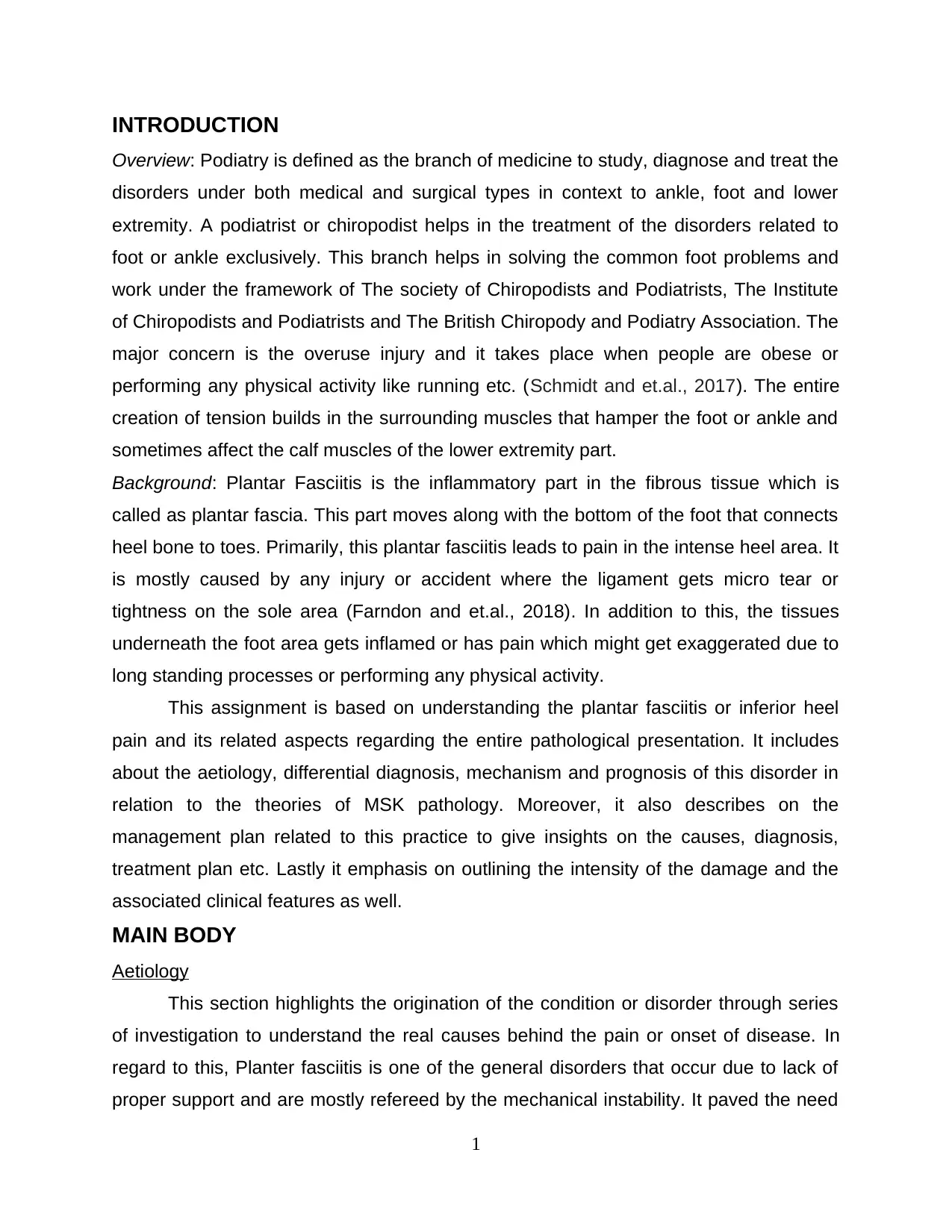
INTRODUCTION
Overview: Podiatry is defined as the branch of medicine to study, diagnose and treat the
disorders under both medical and surgical types in context to ankle, foot and lower
extremity. A podiatrist or chiropodist helps in the treatment of the disorders related to
foot or ankle exclusively. This branch helps in solving the common foot problems and
work under the framework of The society of Chiropodists and Podiatrists, The Institute
of Chiropodists and Podiatrists and The British Chiropody and Podiatry Association. The
major concern is the overuse injury and it takes place when people are obese or
performing any physical activity like running etc. (Schmidt and et.al., 2017). The entire
creation of tension builds in the surrounding muscles that hamper the foot or ankle and
sometimes affect the calf muscles of the lower extremity part.
Background: Plantar Fasciitis is the inflammatory part in the fibrous tissue which is
called as plantar fascia. This part moves along with the bottom of the foot that connects
heel bone to toes. Primarily, this plantar fasciitis leads to pain in the intense heel area. It
is mostly caused by any injury or accident where the ligament gets micro tear or
tightness on the sole area (Farndon and et.al., 2018). In addition to this, the tissues
underneath the foot area gets inflamed or has pain which might get exaggerated due to
long standing processes or performing any physical activity.
This assignment is based on understanding the plantar fasciitis or inferior heel
pain and its related aspects regarding the entire pathological presentation. It includes
about the aetiology, differential diagnosis, mechanism and prognosis of this disorder in
relation to the theories of MSK pathology. Moreover, it also describes on the
management plan related to this practice to give insights on the causes, diagnosis,
treatment plan etc. Lastly it emphasis on outlining the intensity of the damage and the
associated clinical features as well.
MAIN BODY
Aetiology
This section highlights the origination of the condition or disorder through series
of investigation to understand the real causes behind the pain or onset of disease. In
regard to this, Planter fasciitis is one of the general disorders that occur due to lack of
proper support and are mostly refereed by the mechanical instability. It paved the need
1
Overview: Podiatry is defined as the branch of medicine to study, diagnose and treat the
disorders under both medical and surgical types in context to ankle, foot and lower
extremity. A podiatrist or chiropodist helps in the treatment of the disorders related to
foot or ankle exclusively. This branch helps in solving the common foot problems and
work under the framework of The society of Chiropodists and Podiatrists, The Institute
of Chiropodists and Podiatrists and The British Chiropody and Podiatry Association. The
major concern is the overuse injury and it takes place when people are obese or
performing any physical activity like running etc. (Schmidt and et.al., 2017). The entire
creation of tension builds in the surrounding muscles that hamper the foot or ankle and
sometimes affect the calf muscles of the lower extremity part.
Background: Plantar Fasciitis is the inflammatory part in the fibrous tissue which is
called as plantar fascia. This part moves along with the bottom of the foot that connects
heel bone to toes. Primarily, this plantar fasciitis leads to pain in the intense heel area. It
is mostly caused by any injury or accident where the ligament gets micro tear or
tightness on the sole area (Farndon and et.al., 2018). In addition to this, the tissues
underneath the foot area gets inflamed or has pain which might get exaggerated due to
long standing processes or performing any physical activity.
This assignment is based on understanding the plantar fasciitis or inferior heel
pain and its related aspects regarding the entire pathological presentation. It includes
about the aetiology, differential diagnosis, mechanism and prognosis of this disorder in
relation to the theories of MSK pathology. Moreover, it also describes on the
management plan related to this practice to give insights on the causes, diagnosis,
treatment plan etc. Lastly it emphasis on outlining the intensity of the damage and the
associated clinical features as well.
MAIN BODY
Aetiology
This section highlights the origination of the condition or disorder through series
of investigation to understand the real causes behind the pain or onset of disease. In
regard to this, Planter fasciitis is one of the general disorders that occur due to lack of
proper support and are mostly refereed by the mechanical instability. It paved the need
1
⊘ This is a preview!⊘
Do you want full access?
Subscribe today to unlock all pages.

Trusted by 1+ million students worldwide
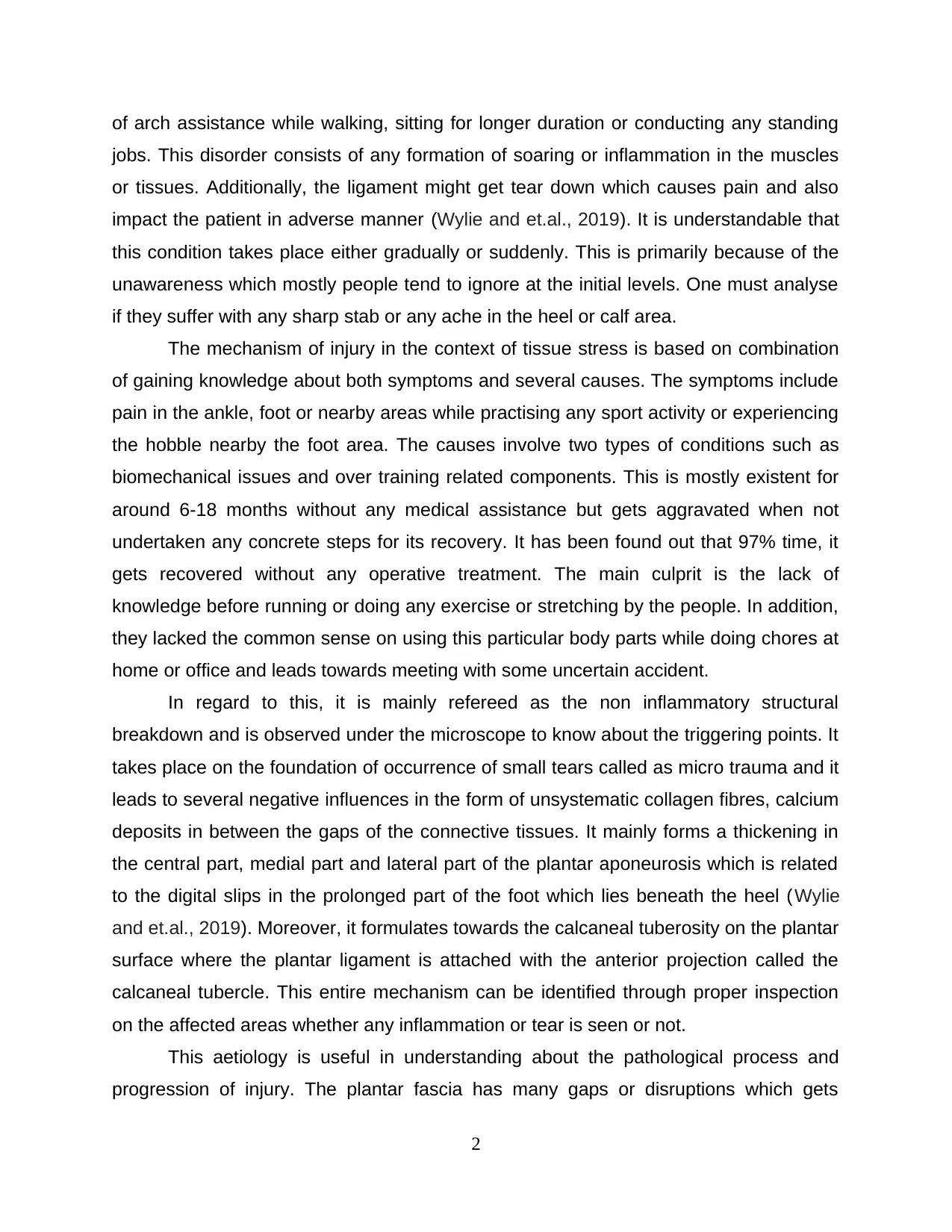
of arch assistance while walking, sitting for longer duration or conducting any standing
jobs. This disorder consists of any formation of soaring or inflammation in the muscles
or tissues. Additionally, the ligament might get tear down which causes pain and also
impact the patient in adverse manner (Wylie and et.al., 2019). It is understandable that
this condition takes place either gradually or suddenly. This is primarily because of the
unawareness which mostly people tend to ignore at the initial levels. One must analyse
if they suffer with any sharp stab or any ache in the heel or calf area.
The mechanism of injury in the context of tissue stress is based on combination
of gaining knowledge about both symptoms and several causes. The symptoms include
pain in the ankle, foot or nearby areas while practising any sport activity or experiencing
the hobble nearby the foot area. The causes involve two types of conditions such as
biomechanical issues and over training related components. This is mostly existent for
around 6-18 months without any medical assistance but gets aggravated when not
undertaken any concrete steps for its recovery. It has been found out that 97% time, it
gets recovered without any operative treatment. The main culprit is the lack of
knowledge before running or doing any exercise or stretching by the people. In addition,
they lacked the common sense on using this particular body parts while doing chores at
home or office and leads towards meeting with some uncertain accident.
In regard to this, it is mainly refereed as the non inflammatory structural
breakdown and is observed under the microscope to know about the triggering points. It
takes place on the foundation of occurrence of small tears called as micro trauma and it
leads to several negative influences in the form of unsystematic collagen fibres, calcium
deposits in between the gaps of the connective tissues. It mainly forms a thickening in
the central part, medial part and lateral part of the plantar aponeurosis which is related
to the digital slips in the prolonged part of the foot which lies beneath the heel ( Wylie
and et.al., 2019). Moreover, it formulates towards the calcaneal tuberosity on the plantar
surface where the plantar ligament is attached with the anterior projection called the
calcaneal tubercle. This entire mechanism can be identified through proper inspection
on the affected areas whether any inflammation or tear is seen or not.
This aetiology is useful in understanding about the pathological process and
progression of injury. The plantar fascia has many gaps or disruptions which gets
2
jobs. This disorder consists of any formation of soaring or inflammation in the muscles
or tissues. Additionally, the ligament might get tear down which causes pain and also
impact the patient in adverse manner (Wylie and et.al., 2019). It is understandable that
this condition takes place either gradually or suddenly. This is primarily because of the
unawareness which mostly people tend to ignore at the initial levels. One must analyse
if they suffer with any sharp stab or any ache in the heel or calf area.
The mechanism of injury in the context of tissue stress is based on combination
of gaining knowledge about both symptoms and several causes. The symptoms include
pain in the ankle, foot or nearby areas while practising any sport activity or experiencing
the hobble nearby the foot area. The causes involve two types of conditions such as
biomechanical issues and over training related components. This is mostly existent for
around 6-18 months without any medical assistance but gets aggravated when not
undertaken any concrete steps for its recovery. It has been found out that 97% time, it
gets recovered without any operative treatment. The main culprit is the lack of
knowledge before running or doing any exercise or stretching by the people. In addition,
they lacked the common sense on using this particular body parts while doing chores at
home or office and leads towards meeting with some uncertain accident.
In regard to this, it is mainly refereed as the non inflammatory structural
breakdown and is observed under the microscope to know about the triggering points. It
takes place on the foundation of occurrence of small tears called as micro trauma and it
leads to several negative influences in the form of unsystematic collagen fibres, calcium
deposits in between the gaps of the connective tissues. It mainly forms a thickening in
the central part, medial part and lateral part of the plantar aponeurosis which is related
to the digital slips in the prolonged part of the foot which lies beneath the heel ( Wylie
and et.al., 2019). Moreover, it formulates towards the calcaneal tuberosity on the plantar
surface where the plantar ligament is attached with the anterior projection called the
calcaneal tubercle. This entire mechanism can be identified through proper inspection
on the affected areas whether any inflammation or tear is seen or not.
This aetiology is useful in understanding about the pathological process and
progression of injury. The plantar fascia has many gaps or disruptions which gets
2
Paraphrase This Document
Need a fresh take? Get an instant paraphrase of this document with our AI Paraphraser
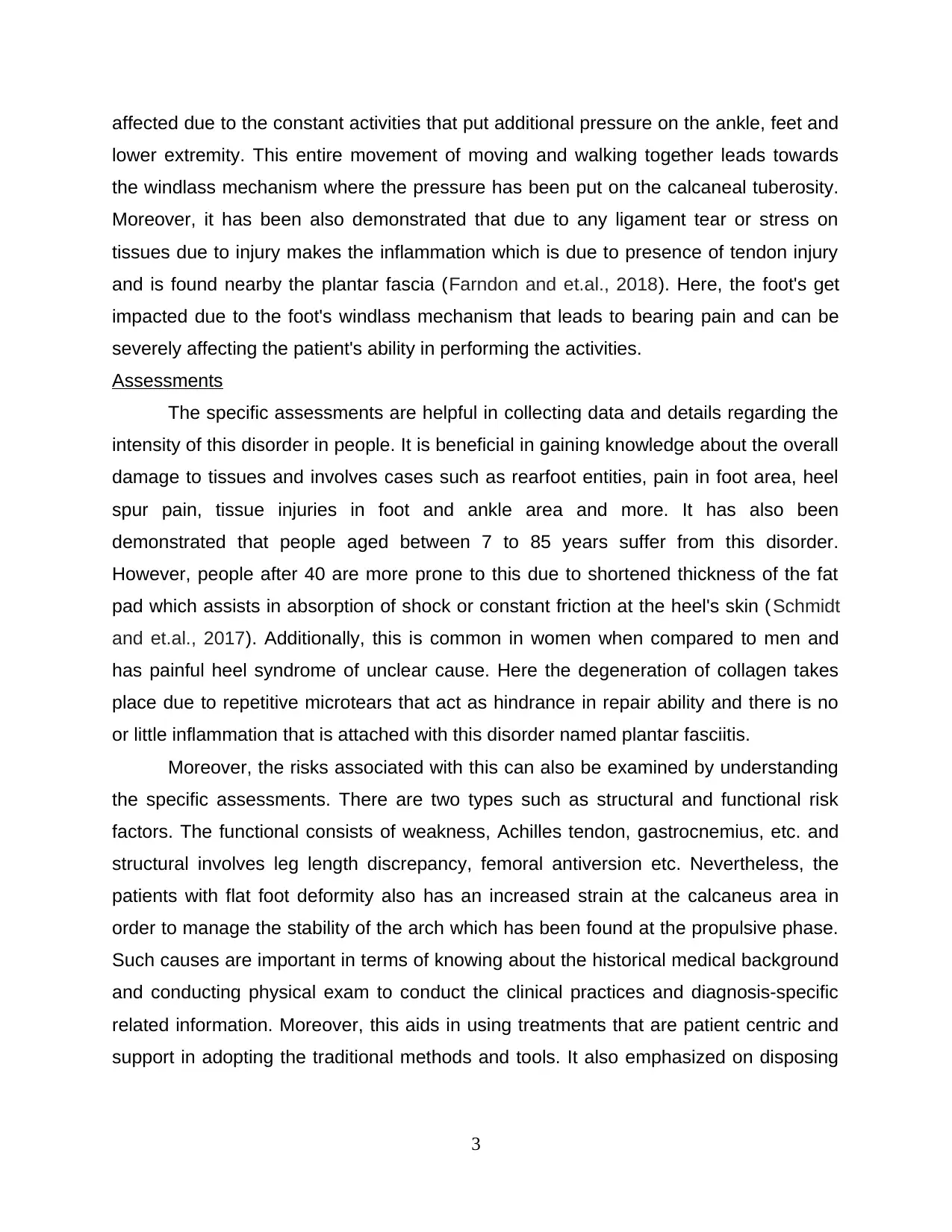
affected due to the constant activities that put additional pressure on the ankle, feet and
lower extremity. This entire movement of moving and walking together leads towards
the windlass mechanism where the pressure has been put on the calcaneal tuberosity.
Moreover, it has been also demonstrated that due to any ligament tear or stress on
tissues due to injury makes the inflammation which is due to presence of tendon injury
and is found nearby the plantar fascia (Farndon and et.al., 2018). Here, the foot's get
impacted due to the foot's windlass mechanism that leads to bearing pain and can be
severely affecting the patient's ability in performing the activities.
Assessments
The specific assessments are helpful in collecting data and details regarding the
intensity of this disorder in people. It is beneficial in gaining knowledge about the overall
damage to tissues and involves cases such as rearfoot entities, pain in foot area, heel
spur pain, tissue injuries in foot and ankle area and more. It has also been
demonstrated that people aged between 7 to 85 years suffer from this disorder.
However, people after 40 are more prone to this due to shortened thickness of the fat
pad which assists in absorption of shock or constant friction at the heel's skin (Schmidt
and et.al., 2017). Additionally, this is common in women when compared to men and
has painful heel syndrome of unclear cause. Here the degeneration of collagen takes
place due to repetitive microtears that act as hindrance in repair ability and there is no
or little inflammation that is attached with this disorder named plantar fasciitis.
Moreover, the risks associated with this can also be examined by understanding
the specific assessments. There are two types such as structural and functional risk
factors. The functional consists of weakness, Achilles tendon, gastrocnemius, etc. and
structural involves leg length discrepancy, femoral antiversion etc. Nevertheless, the
patients with flat foot deformity also has an increased strain at the calcaneus area in
order to manage the stability of the arch which has been found at the propulsive phase.
Such causes are important in terms of knowing about the historical medical background
and conducting physical exam to conduct the clinical practices and diagnosis-specific
related information. Moreover, this aids in using treatments that are patient centric and
support in adopting the traditional methods and tools. It also emphasized on disposing
3
lower extremity. This entire movement of moving and walking together leads towards
the windlass mechanism where the pressure has been put on the calcaneal tuberosity.
Moreover, it has been also demonstrated that due to any ligament tear or stress on
tissues due to injury makes the inflammation which is due to presence of tendon injury
and is found nearby the plantar fascia (Farndon and et.al., 2018). Here, the foot's get
impacted due to the foot's windlass mechanism that leads to bearing pain and can be
severely affecting the patient's ability in performing the activities.
Assessments
The specific assessments are helpful in collecting data and details regarding the
intensity of this disorder in people. It is beneficial in gaining knowledge about the overall
damage to tissues and involves cases such as rearfoot entities, pain in foot area, heel
spur pain, tissue injuries in foot and ankle area and more. It has also been
demonstrated that people aged between 7 to 85 years suffer from this disorder.
However, people after 40 are more prone to this due to shortened thickness of the fat
pad which assists in absorption of shock or constant friction at the heel's skin (Schmidt
and et.al., 2017). Additionally, this is common in women when compared to men and
has painful heel syndrome of unclear cause. Here the degeneration of collagen takes
place due to repetitive microtears that act as hindrance in repair ability and there is no
or little inflammation that is attached with this disorder named plantar fasciitis.
Moreover, the risks associated with this can also be examined by understanding
the specific assessments. There are two types such as structural and functional risk
factors. The functional consists of weakness, Achilles tendon, gastrocnemius, etc. and
structural involves leg length discrepancy, femoral antiversion etc. Nevertheless, the
patients with flat foot deformity also has an increased strain at the calcaneus area in
order to manage the stability of the arch which has been found at the propulsive phase.
Such causes are important in terms of knowing about the historical medical background
and conducting physical exam to conduct the clinical practices and diagnosis-specific
related information. Moreover, this aids in using treatments that are patient centric and
support in adopting the traditional methods and tools. It also emphasized on disposing
3
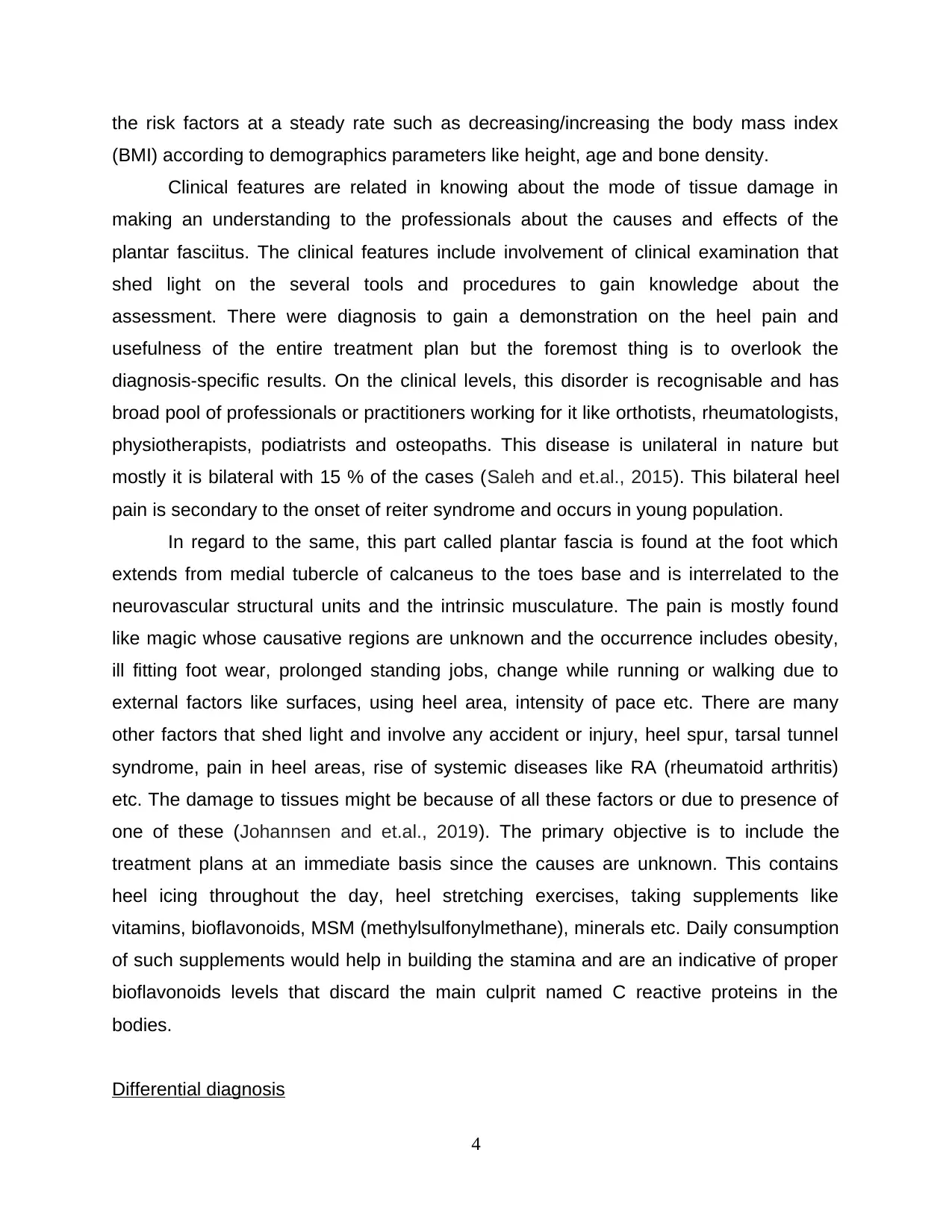
the risk factors at a steady rate such as decreasing/increasing the body mass index
(BMI) according to demographics parameters like height, age and bone density.
Clinical features are related in knowing about the mode of tissue damage in
making an understanding to the professionals about the causes and effects of the
plantar fasciitus. The clinical features include involvement of clinical examination that
shed light on the several tools and procedures to gain knowledge about the
assessment. There were diagnosis to gain a demonstration on the heel pain and
usefulness of the entire treatment plan but the foremost thing is to overlook the
diagnosis-specific results. On the clinical levels, this disorder is recognisable and has
broad pool of professionals or practitioners working for it like orthotists, rheumatologists,
physiotherapists, podiatrists and osteopaths. This disease is unilateral in nature but
mostly it is bilateral with 15 % of the cases (Saleh and et.al., 2015). This bilateral heel
pain is secondary to the onset of reiter syndrome and occurs in young population.
In regard to the same, this part called plantar fascia is found at the foot which
extends from medial tubercle of calcaneus to the toes base and is interrelated to the
neurovascular structural units and the intrinsic musculature. The pain is mostly found
like magic whose causative regions are unknown and the occurrence includes obesity,
ill fitting foot wear, prolonged standing jobs, change while running or walking due to
external factors like surfaces, using heel area, intensity of pace etc. There are many
other factors that shed light and involve any accident or injury, heel spur, tarsal tunnel
syndrome, pain in heel areas, rise of systemic diseases like RA (rheumatoid arthritis)
etc. The damage to tissues might be because of all these factors or due to presence of
one of these (Johannsen and et.al., 2019). The primary objective is to include the
treatment plans at an immediate basis since the causes are unknown. This contains
heel icing throughout the day, heel stretching exercises, taking supplements like
vitamins, bioflavonoids, MSM (methylsulfonylmethane), minerals etc. Daily consumption
of such supplements would help in building the stamina and are an indicative of proper
bioflavonoids levels that discard the main culprit named C reactive proteins in the
bodies.
Differential diagnosis
4
(BMI) according to demographics parameters like height, age and bone density.
Clinical features are related in knowing about the mode of tissue damage in
making an understanding to the professionals about the causes and effects of the
plantar fasciitus. The clinical features include involvement of clinical examination that
shed light on the several tools and procedures to gain knowledge about the
assessment. There were diagnosis to gain a demonstration on the heel pain and
usefulness of the entire treatment plan but the foremost thing is to overlook the
diagnosis-specific results. On the clinical levels, this disorder is recognisable and has
broad pool of professionals or practitioners working for it like orthotists, rheumatologists,
physiotherapists, podiatrists and osteopaths. This disease is unilateral in nature but
mostly it is bilateral with 15 % of the cases (Saleh and et.al., 2015). This bilateral heel
pain is secondary to the onset of reiter syndrome and occurs in young population.
In regard to the same, this part called plantar fascia is found at the foot which
extends from medial tubercle of calcaneus to the toes base and is interrelated to the
neurovascular structural units and the intrinsic musculature. The pain is mostly found
like magic whose causative regions are unknown and the occurrence includes obesity,
ill fitting foot wear, prolonged standing jobs, change while running or walking due to
external factors like surfaces, using heel area, intensity of pace etc. There are many
other factors that shed light and involve any accident or injury, heel spur, tarsal tunnel
syndrome, pain in heel areas, rise of systemic diseases like RA (rheumatoid arthritis)
etc. The damage to tissues might be because of all these factors or due to presence of
one of these (Johannsen and et.al., 2019). The primary objective is to include the
treatment plans at an immediate basis since the causes are unknown. This contains
heel icing throughout the day, heel stretching exercises, taking supplements like
vitamins, bioflavonoids, MSM (methylsulfonylmethane), minerals etc. Daily consumption
of such supplements would help in building the stamina and are an indicative of proper
bioflavonoids levels that discard the main culprit named C reactive proteins in the
bodies.
Differential diagnosis
4
⊘ This is a preview!⊘
Do you want full access?
Subscribe today to unlock all pages.

Trusted by 1+ million students worldwide
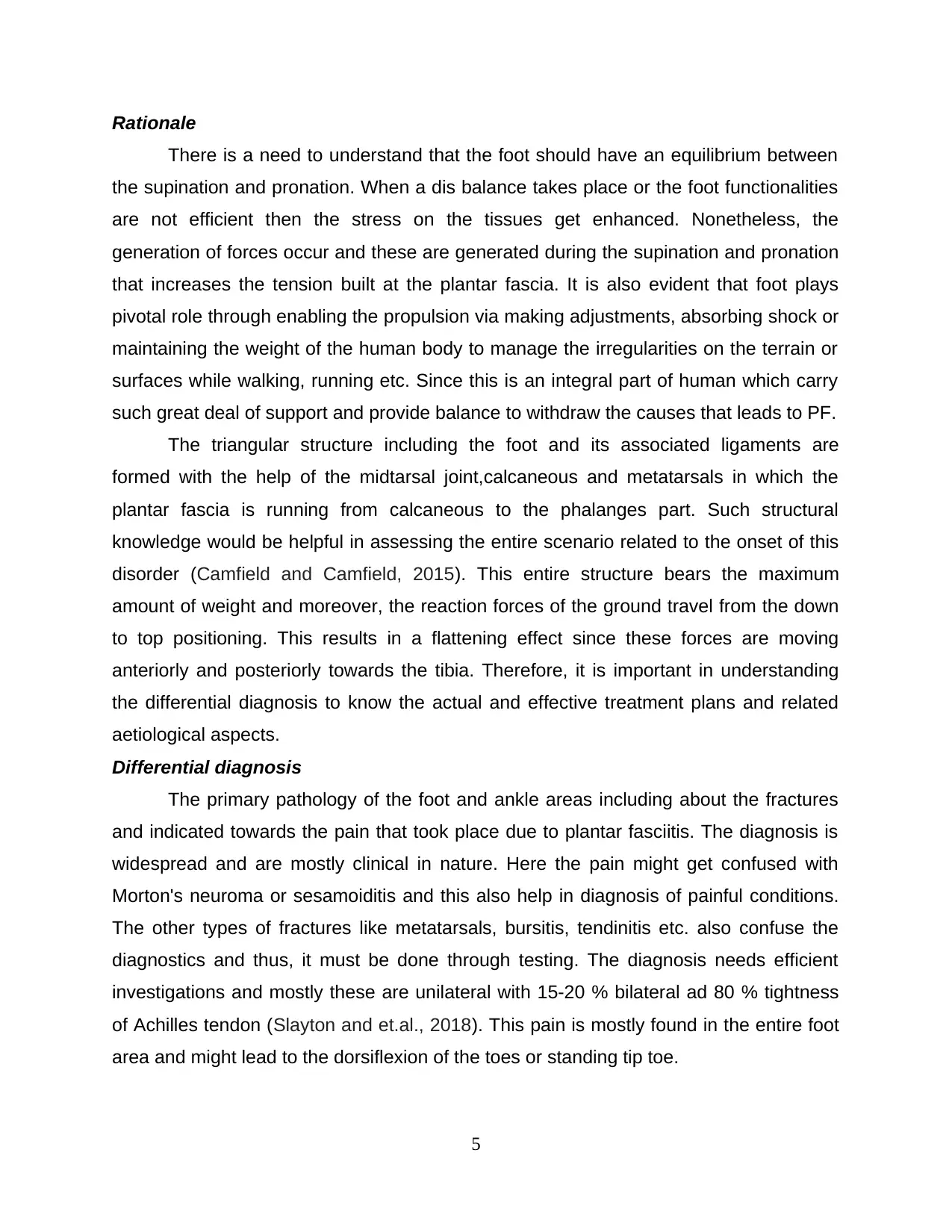
Rationale
There is a need to understand that the foot should have an equilibrium between
the supination and pronation. When a dis balance takes place or the foot functionalities
are not efficient then the stress on the tissues get enhanced. Nonetheless, the
generation of forces occur and these are generated during the supination and pronation
that increases the tension built at the plantar fascia. It is also evident that foot plays
pivotal role through enabling the propulsion via making adjustments, absorbing shock or
maintaining the weight of the human body to manage the irregularities on the terrain or
surfaces while walking, running etc. Since this is an integral part of human which carry
such great deal of support and provide balance to withdraw the causes that leads to PF.
The triangular structure including the foot and its associated ligaments are
formed with the help of the midtarsal joint,calcaneous and metatarsals in which the
plantar fascia is running from calcaneous to the phalanges part. Such structural
knowledge would be helpful in assessing the entire scenario related to the onset of this
disorder (Camfield and Camfield, 2015). This entire structure bears the maximum
amount of weight and moreover, the reaction forces of the ground travel from the down
to top positioning. This results in a flattening effect since these forces are moving
anteriorly and posteriorly towards the tibia. Therefore, it is important in understanding
the differential diagnosis to know the actual and effective treatment plans and related
aetiological aspects.
Differential diagnosis
The primary pathology of the foot and ankle areas including about the fractures
and indicated towards the pain that took place due to plantar fasciitis. The diagnosis is
widespread and are mostly clinical in nature. Here the pain might get confused with
Morton's neuroma or sesamoiditis and this also help in diagnosis of painful conditions.
The other types of fractures like metatarsals, bursitis, tendinitis etc. also confuse the
diagnostics and thus, it must be done through testing. The diagnosis needs efficient
investigations and mostly these are unilateral with 15-20 % bilateral ad 80 % tightness
of Achilles tendon (Slayton and et.al., 2018). This pain is mostly found in the entire foot
area and might lead to the dorsiflexion of the toes or standing tip toe.
5
There is a need to understand that the foot should have an equilibrium between
the supination and pronation. When a dis balance takes place or the foot functionalities
are not efficient then the stress on the tissues get enhanced. Nonetheless, the
generation of forces occur and these are generated during the supination and pronation
that increases the tension built at the plantar fascia. It is also evident that foot plays
pivotal role through enabling the propulsion via making adjustments, absorbing shock or
maintaining the weight of the human body to manage the irregularities on the terrain or
surfaces while walking, running etc. Since this is an integral part of human which carry
such great deal of support and provide balance to withdraw the causes that leads to PF.
The triangular structure including the foot and its associated ligaments are
formed with the help of the midtarsal joint,calcaneous and metatarsals in which the
plantar fascia is running from calcaneous to the phalanges part. Such structural
knowledge would be helpful in assessing the entire scenario related to the onset of this
disorder (Camfield and Camfield, 2015). This entire structure bears the maximum
amount of weight and moreover, the reaction forces of the ground travel from the down
to top positioning. This results in a flattening effect since these forces are moving
anteriorly and posteriorly towards the tibia. Therefore, it is important in understanding
the differential diagnosis to know the actual and effective treatment plans and related
aetiological aspects.
Differential diagnosis
The primary pathology of the foot and ankle areas including about the fractures
and indicated towards the pain that took place due to plantar fasciitis. The diagnosis is
widespread and are mostly clinical in nature. Here the pain might get confused with
Morton's neuroma or sesamoiditis and this also help in diagnosis of painful conditions.
The other types of fractures like metatarsals, bursitis, tendinitis etc. also confuse the
diagnostics and thus, it must be done through testing. The diagnosis needs efficient
investigations and mostly these are unilateral with 15-20 % bilateral ad 80 % tightness
of Achilles tendon (Slayton and et.al., 2018). This pain is mostly found in the entire foot
area and might lead to the dorsiflexion of the toes or standing tip toe.
5
Paraphrase This Document
Need a fresh take? Get an instant paraphrase of this document with our AI Paraphraser
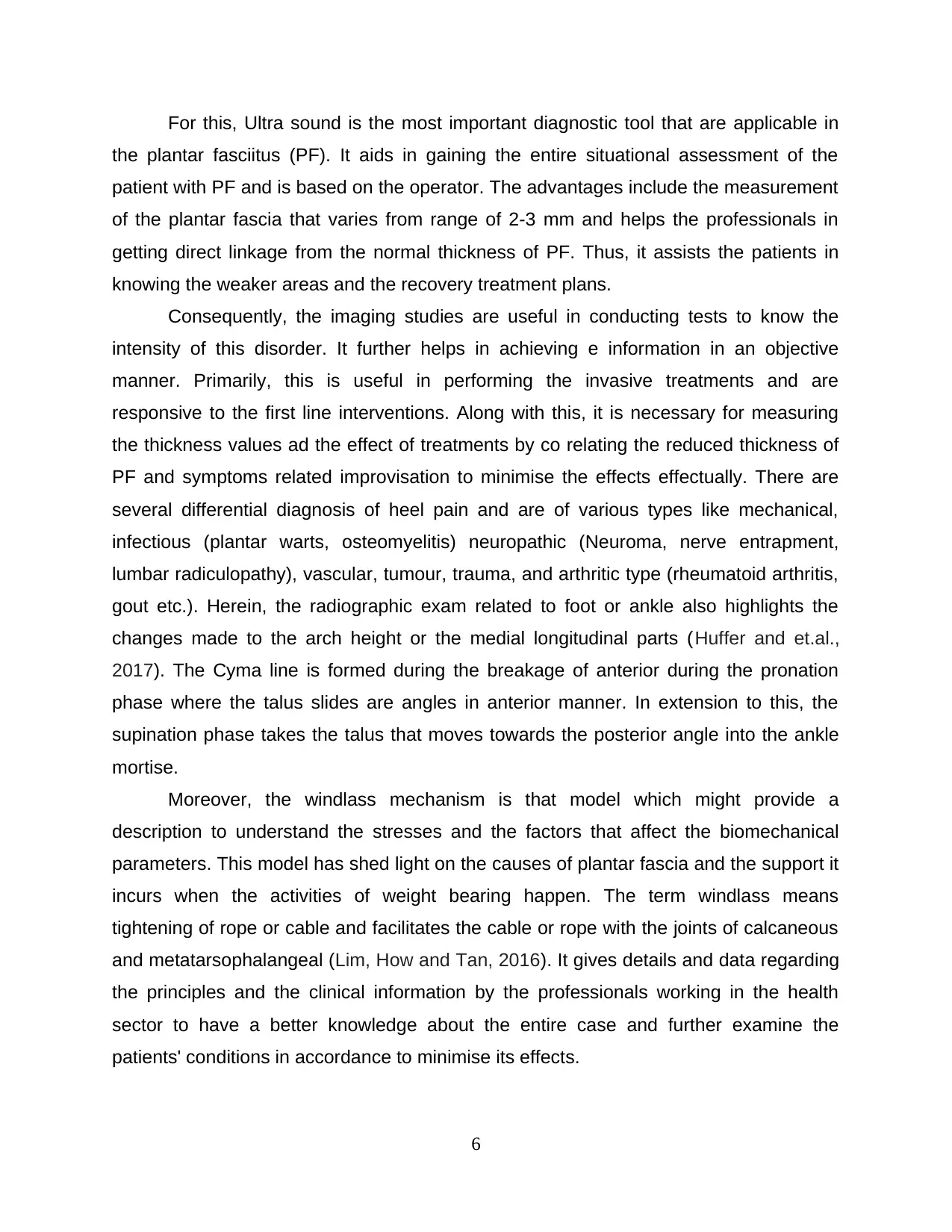
For this, Ultra sound is the most important diagnostic tool that are applicable in
the plantar fasciitus (PF). It aids in gaining the entire situational assessment of the
patient with PF and is based on the operator. The advantages include the measurement
of the plantar fascia that varies from range of 2-3 mm and helps the professionals in
getting direct linkage from the normal thickness of PF. Thus, it assists the patients in
knowing the weaker areas and the recovery treatment plans.
Consequently, the imaging studies are useful in conducting tests to know the
intensity of this disorder. It further helps in achieving e information in an objective
manner. Primarily, this is useful in performing the invasive treatments and are
responsive to the first line interventions. Along with this, it is necessary for measuring
the thickness values ad the effect of treatments by co relating the reduced thickness of
PF and symptoms related improvisation to minimise the effects effectually. There are
several differential diagnosis of heel pain and are of various types like mechanical,
infectious (plantar warts, osteomyelitis) neuropathic (Neuroma, nerve entrapment,
lumbar radiculopathy), vascular, tumour, trauma, and arthritic type (rheumatoid arthritis,
gout etc.). Herein, the radiographic exam related to foot or ankle also highlights the
changes made to the arch height or the medial longitudinal parts (Huffer and et.al.,
2017). The Cyma line is formed during the breakage of anterior during the pronation
phase where the talus slides are angles in anterior manner. In extension to this, the
supination phase takes the talus that moves towards the posterior angle into the ankle
mortise.
Moreover, the windlass mechanism is that model which might provide a
description to understand the stresses and the factors that affect the biomechanical
parameters. This model has shed light on the causes of plantar fascia and the support it
incurs when the activities of weight bearing happen. The term windlass means
tightening of rope or cable and facilitates the cable or rope with the joints of calcaneous
and metatarsophalangeal (Lim, How and Tan, 2016). It gives details and data regarding
the principles and the clinical information by the professionals working in the health
sector to have a better knowledge about the entire case and further examine the
patients' conditions in accordance to minimise its effects.
6
the plantar fasciitus (PF). It aids in gaining the entire situational assessment of the
patient with PF and is based on the operator. The advantages include the measurement
of the plantar fascia that varies from range of 2-3 mm and helps the professionals in
getting direct linkage from the normal thickness of PF. Thus, it assists the patients in
knowing the weaker areas and the recovery treatment plans.
Consequently, the imaging studies are useful in conducting tests to know the
intensity of this disorder. It further helps in achieving e information in an objective
manner. Primarily, this is useful in performing the invasive treatments and are
responsive to the first line interventions. Along with this, it is necessary for measuring
the thickness values ad the effect of treatments by co relating the reduced thickness of
PF and symptoms related improvisation to minimise the effects effectually. There are
several differential diagnosis of heel pain and are of various types like mechanical,
infectious (plantar warts, osteomyelitis) neuropathic (Neuroma, nerve entrapment,
lumbar radiculopathy), vascular, tumour, trauma, and arthritic type (rheumatoid arthritis,
gout etc.). Herein, the radiographic exam related to foot or ankle also highlights the
changes made to the arch height or the medial longitudinal parts (Huffer and et.al.,
2017). The Cyma line is formed during the breakage of anterior during the pronation
phase where the talus slides are angles in anterior manner. In extension to this, the
supination phase takes the talus that moves towards the posterior angle into the ankle
mortise.
Moreover, the windlass mechanism is that model which might provide a
description to understand the stresses and the factors that affect the biomechanical
parameters. This model has shed light on the causes of plantar fascia and the support it
incurs when the activities of weight bearing happen. The term windlass means
tightening of rope or cable and facilitates the cable or rope with the joints of calcaneous
and metatarsophalangeal (Lim, How and Tan, 2016). It gives details and data regarding
the principles and the clinical information by the professionals working in the health
sector to have a better knowledge about the entire case and further examine the
patients' conditions in accordance to minimise its effects.
6
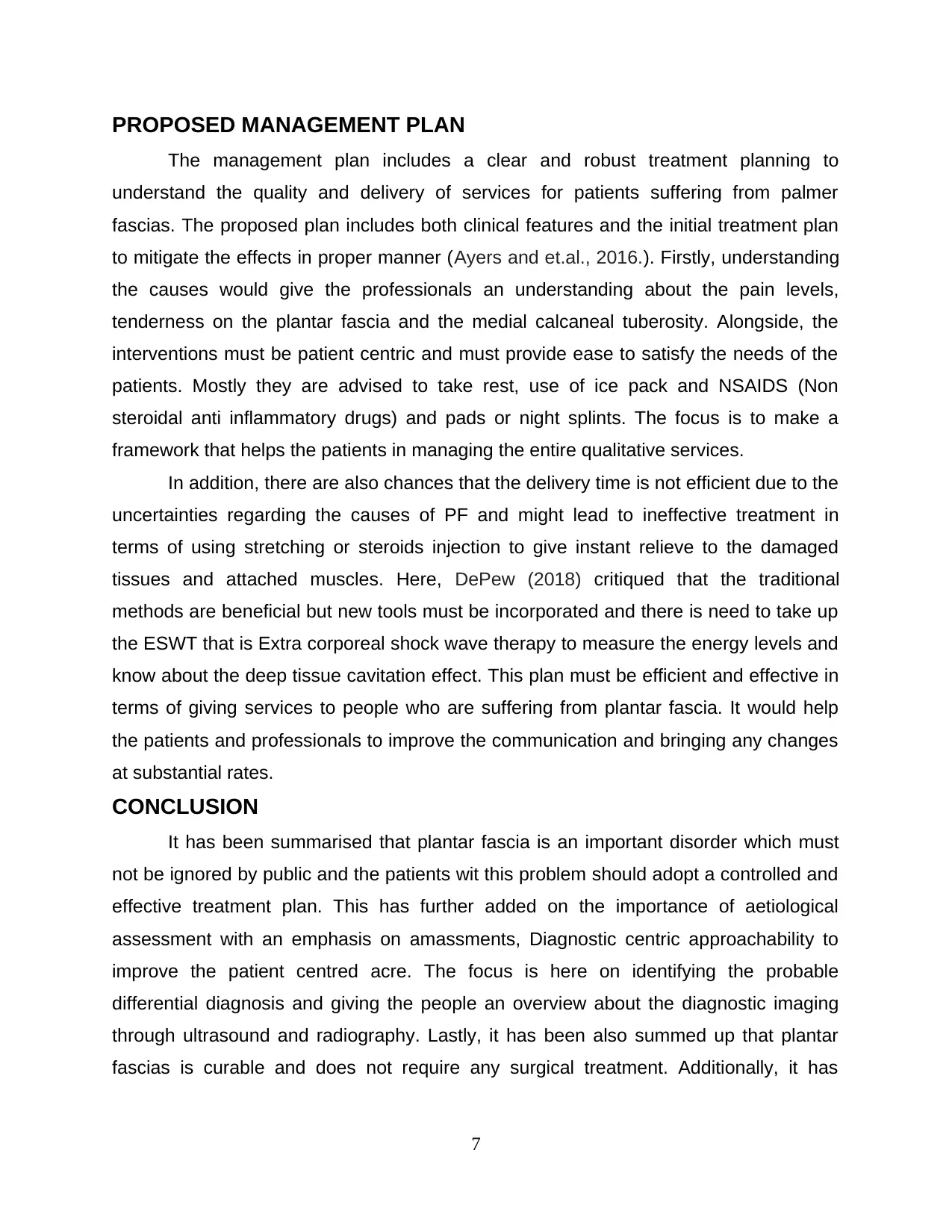
PROPOSED MANAGEMENT PLAN
The management plan includes a clear and robust treatment planning to
understand the quality and delivery of services for patients suffering from palmer
fascias. The proposed plan includes both clinical features and the initial treatment plan
to mitigate the effects in proper manner (Ayers and et.al., 2016.). Firstly, understanding
the causes would give the professionals an understanding about the pain levels,
tenderness on the plantar fascia and the medial calcaneal tuberosity. Alongside, the
interventions must be patient centric and must provide ease to satisfy the needs of the
patients. Mostly they are advised to take rest, use of ice pack and NSAIDS (Non
steroidal anti inflammatory drugs) and pads or night splints. The focus is to make a
framework that helps the patients in managing the entire qualitative services.
In addition, there are also chances that the delivery time is not efficient due to the
uncertainties regarding the causes of PF and might lead to ineffective treatment in
terms of using stretching or steroids injection to give instant relieve to the damaged
tissues and attached muscles. Here, DePew (2018) critiqued that the traditional
methods are beneficial but new tools must be incorporated and there is need to take up
the ESWT that is Extra corporeal shock wave therapy to measure the energy levels and
know about the deep tissue cavitation effect. This plan must be efficient and effective in
terms of giving services to people who are suffering from plantar fascia. It would help
the patients and professionals to improve the communication and bringing any changes
at substantial rates.
CONCLUSION
It has been summarised that plantar fascia is an important disorder which must
not be ignored by public and the patients wit this problem should adopt a controlled and
effective treatment plan. This has further added on the importance of aetiological
assessment with an emphasis on amassments, Diagnostic centric approachability to
improve the patient centred acre. The focus is here on identifying the probable
differential diagnosis and giving the people an overview about the diagnostic imaging
through ultrasound and radiography. Lastly, it has been also summed up that plantar
fascias is curable and does not require any surgical treatment. Additionally, it has
7
The management plan includes a clear and robust treatment planning to
understand the quality and delivery of services for patients suffering from palmer
fascias. The proposed plan includes both clinical features and the initial treatment plan
to mitigate the effects in proper manner (Ayers and et.al., 2016.). Firstly, understanding
the causes would give the professionals an understanding about the pain levels,
tenderness on the plantar fascia and the medial calcaneal tuberosity. Alongside, the
interventions must be patient centric and must provide ease to satisfy the needs of the
patients. Mostly they are advised to take rest, use of ice pack and NSAIDS (Non
steroidal anti inflammatory drugs) and pads or night splints. The focus is to make a
framework that helps the patients in managing the entire qualitative services.
In addition, there are also chances that the delivery time is not efficient due to the
uncertainties regarding the causes of PF and might lead to ineffective treatment in
terms of using stretching or steroids injection to give instant relieve to the damaged
tissues and attached muscles. Here, DePew (2018) critiqued that the traditional
methods are beneficial but new tools must be incorporated and there is need to take up
the ESWT that is Extra corporeal shock wave therapy to measure the energy levels and
know about the deep tissue cavitation effect. This plan must be efficient and effective in
terms of giving services to people who are suffering from plantar fascia. It would help
the patients and professionals to improve the communication and bringing any changes
at substantial rates.
CONCLUSION
It has been summarised that plantar fascia is an important disorder which must
not be ignored by public and the patients wit this problem should adopt a controlled and
effective treatment plan. This has further added on the importance of aetiological
assessment with an emphasis on amassments, Diagnostic centric approachability to
improve the patient centred acre. The focus is here on identifying the probable
differential diagnosis and giving the people an overview about the diagnostic imaging
through ultrasound and radiography. Lastly, it has been also summed up that plantar
fascias is curable and does not require any surgical treatment. Additionally, it has
7
⊘ This is a preview!⊘
Do you want full access?
Subscribe today to unlock all pages.

Trusted by 1+ million students worldwide

highlighted the need to know about the implications of this disorder and give a range of
techniques, tools and methods to both the professionals and patients.
8
techniques, tools and methods to both the professionals and patients.
8
Paraphrase This Document
Need a fresh take? Get an instant paraphrase of this document with our AI Paraphraser
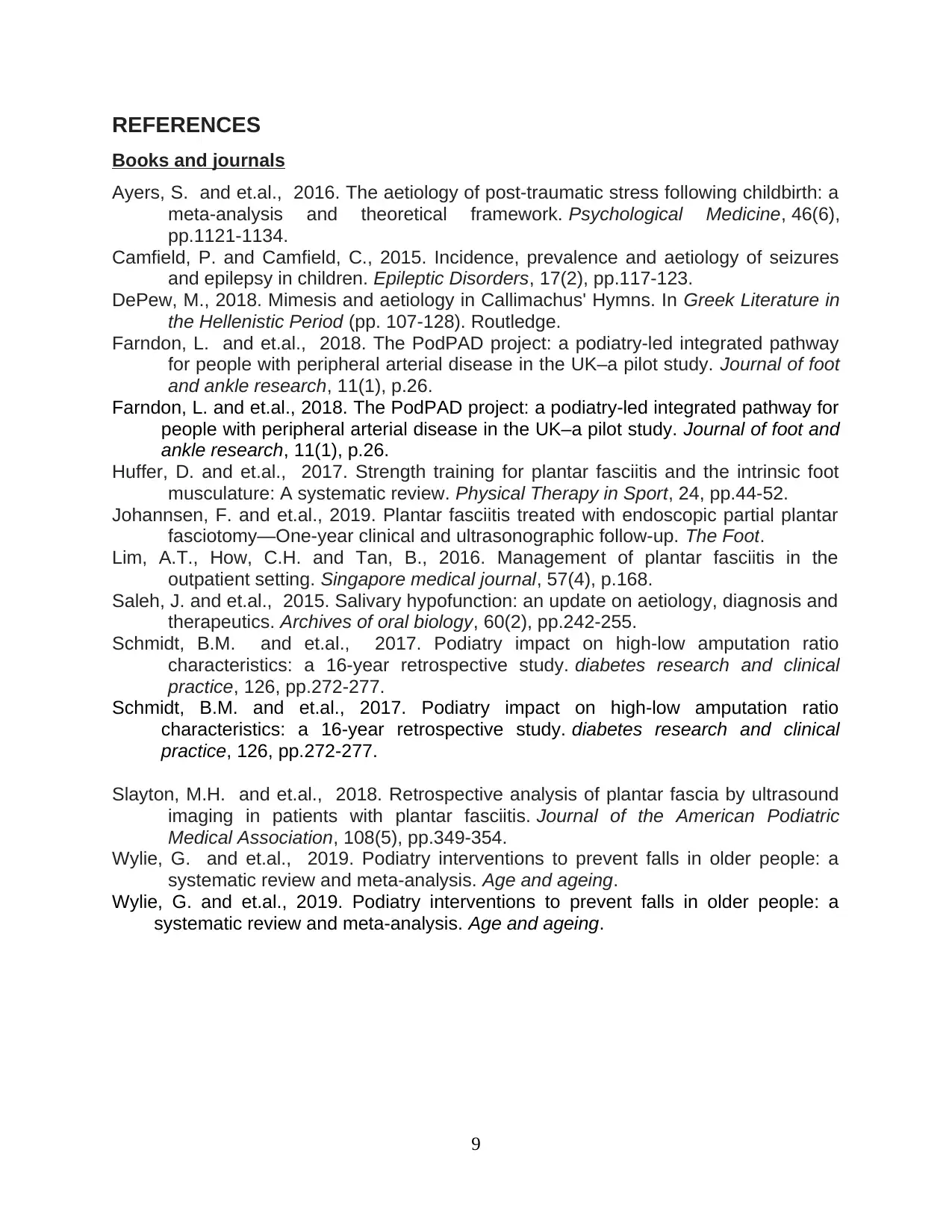
REFERENCES
Books and journals
Ayers, S. and et.al., 2016. The aetiology of post-traumatic stress following childbirth: a
meta-analysis and theoretical framework. Psychological Medicine, 46(6),
pp.1121-1134.
Camfield, P. and Camfield, C., 2015. Incidence, prevalence and aetiology of seizures
and epilepsy in children. Epileptic Disorders, 17(2), pp.117-123.
DePew, M., 2018. Mimesis and aetiology in Callimachus' Hymns. In Greek Literature in
the Hellenistic Period (pp. 107-128). Routledge.
Farndon, L. and et.al., 2018. The PodPAD project: a podiatry-led integrated pathway
for people with peripheral arterial disease in the UK–a pilot study. Journal of foot
and ankle research, 11(1), p.26.
Farndon, L. and et.al., 2018. The PodPAD project: a podiatry-led integrated pathway for
people with peripheral arterial disease in the UK–a pilot study. Journal of foot and
ankle research, 11(1), p.26.
Huffer, D. and et.al., 2017. Strength training for plantar fasciitis and the intrinsic foot
musculature: A systematic review. Physical Therapy in Sport, 24, pp.44-52.
Johannsen, F. and et.al., 2019. Plantar fasciitis treated with endoscopic partial plantar
fasciotomy—One-year clinical and ultrasonographic follow-up. The Foot.
Lim, A.T., How, C.H. and Tan, B., 2016. Management of plantar fasciitis in the
outpatient setting. Singapore medical journal, 57(4), p.168.
Saleh, J. and et.al., 2015. Salivary hypofunction: an update on aetiology, diagnosis and
therapeutics. Archives of oral biology, 60(2), pp.242-255.
Schmidt, B.M. and et.al., 2017. Podiatry impact on high-low amputation ratio
characteristics: a 16-year retrospective study. diabetes research and clinical
practice, 126, pp.272-277.
Schmidt, B.M. and et.al., 2017. Podiatry impact on high-low amputation ratio
characteristics: a 16-year retrospective study. diabetes research and clinical
practice, 126, pp.272-277.
Slayton, M.H. and et.al., 2018. Retrospective analysis of plantar fascia by ultrasound
imaging in patients with plantar fasciitis. Journal of the American Podiatric
Medical Association, 108(5), pp.349-354.
Wylie, G. and et.al., 2019. Podiatry interventions to prevent falls in older people: a
systematic review and meta-analysis. Age and ageing.
Wylie, G. and et.al., 2019. Podiatry interventions to prevent falls in older people: a
systematic review and meta-analysis. Age and ageing.
9
Books and journals
Ayers, S. and et.al., 2016. The aetiology of post-traumatic stress following childbirth: a
meta-analysis and theoretical framework. Psychological Medicine, 46(6),
pp.1121-1134.
Camfield, P. and Camfield, C., 2015. Incidence, prevalence and aetiology of seizures
and epilepsy in children. Epileptic Disorders, 17(2), pp.117-123.
DePew, M., 2018. Mimesis and aetiology in Callimachus' Hymns. In Greek Literature in
the Hellenistic Period (pp. 107-128). Routledge.
Farndon, L. and et.al., 2018. The PodPAD project: a podiatry-led integrated pathway
for people with peripheral arterial disease in the UK–a pilot study. Journal of foot
and ankle research, 11(1), p.26.
Farndon, L. and et.al., 2018. The PodPAD project: a podiatry-led integrated pathway for
people with peripheral arterial disease in the UK–a pilot study. Journal of foot and
ankle research, 11(1), p.26.
Huffer, D. and et.al., 2017. Strength training for plantar fasciitis and the intrinsic foot
musculature: A systematic review. Physical Therapy in Sport, 24, pp.44-52.
Johannsen, F. and et.al., 2019. Plantar fasciitis treated with endoscopic partial plantar
fasciotomy—One-year clinical and ultrasonographic follow-up. The Foot.
Lim, A.T., How, C.H. and Tan, B., 2016. Management of plantar fasciitis in the
outpatient setting. Singapore medical journal, 57(4), p.168.
Saleh, J. and et.al., 2015. Salivary hypofunction: an update on aetiology, diagnosis and
therapeutics. Archives of oral biology, 60(2), pp.242-255.
Schmidt, B.M. and et.al., 2017. Podiatry impact on high-low amputation ratio
characteristics: a 16-year retrospective study. diabetes research and clinical
practice, 126, pp.272-277.
Schmidt, B.M. and et.al., 2017. Podiatry impact on high-low amputation ratio
characteristics: a 16-year retrospective study. diabetes research and clinical
practice, 126, pp.272-277.
Slayton, M.H. and et.al., 2018. Retrospective analysis of plantar fascia by ultrasound
imaging in patients with plantar fasciitis. Journal of the American Podiatric
Medical Association, 108(5), pp.349-354.
Wylie, G. and et.al., 2019. Podiatry interventions to prevent falls in older people: a
systematic review and meta-analysis. Age and ageing.
Wylie, G. and et.al., 2019. Podiatry interventions to prevent falls in older people: a
systematic review and meta-analysis. Age and ageing.
9

10
⊘ This is a preview!⊘
Do you want full access?
Subscribe today to unlock all pages.

Trusted by 1+ million students worldwide
1 out of 16
Your All-in-One AI-Powered Toolkit for Academic Success.
+13062052269
info@desklib.com
Available 24*7 on WhatsApp / Email
![[object Object]](/_next/static/media/star-bottom.7253800d.svg)
Unlock your academic potential
Copyright © 2020–2025 A2Z Services. All Rights Reserved. Developed and managed by ZUCOL.
